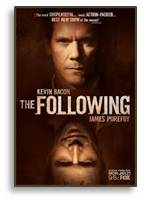 To follow up on Friday’s post about violence in advertising, I have been wondering why an increasing number of TV shows are dedicated not just to violent themes and characters but to pathological characters. We all know that violence on TV is nothing new and I don’t live in a bubble. I grew up with cowboys killing Indians and GIs killing Nazis on network television, so I know a Colt 45 from a BAR.
To follow up on Friday’s post about violence in advertising, I have been wondering why an increasing number of TV shows are dedicated not just to violent themes and characters but to pathological characters. We all know that violence on TV is nothing new and I don’t live in a bubble. I grew up with cowboys killing Indians and GIs killing Nazis on network television, so I know a Colt 45 from a BAR. But the programs released this year take the concept of violence to whole new lows. Consider just these three shows released in 2013:
- The Following: This gruesome show follows “a brilliant and charismatic, yet psychotic serial killer” who communicates with other serial killers and leads a cult of believers. The cult members follow his every command—even allowing him to kill them if they fail. I actually tried a few episodes of The Following (because I like Kevin Bacon) but abandoned it because of the sick violence that permeates the show and the way in which the cult leader is portrayed as virtually omnipotent while the police are systematically incompetent.
- Hannibal: This purported reason for this show is to “explore the early relationship” between the young Hannibal Lecter and an FBI criminal profiler. I don’t even like to watch the promos for something I find so disgusting.
- Bates Motel: A prequel to the 1960 movie Psycho, this program deal with a teenage Norman Bates and his mother Norma who live in that creepy old house overlooking the eponymous motel. I never watched it and never will.
 Don’t get me wrong: I don’t confine my TV viewing to cooking shows, nature programming, and “Antiques Roadshow.” I’m glued to “Game of Thrones” (having read all the books as they came out) and we recently watched two seasons of “StrikeBack.” These are both shows that any objective observer would classify as pretty darn violent.
Don’t get me wrong: I don’t confine my TV viewing to cooking shows, nature programming, and “Antiques Roadshow.” I’m glued to “Game of Thrones” (having read all the books as they came out) and we recently watched two seasons of “StrikeBack.” These are both shows that any objective observer would classify as pretty darn violent.Parsing Shades of Violence
If it’s possible to parse shades of violence, however, I find a real difference between armies and mercenaries waging war and psychopaths murdering individuals. During one episode of @StrikeBackIT, a mercenary named Matlock tries to quit his assignment saying, “I signed up for a coup. That’s soldier’s work.” But he draws the line at supporting his boss’s plan to detonate a nuclear weapon that will kill millions in a major African city.
In that example, fear and death are side effects of fighting to reach a goal. People are killed because someone wants power, wealth, a kingdom, survival, access to resources, freedom, or a combination of these things. The deaths that occur are either essential to reaching that goal or an accidental consequence of the fighting to achieve the goal. That’s life–for better or worse.
For a psychopath, however, the fear, pain, and death of individuals are the goal. On @TheFollowingFOX, cult leader Joe Carroll and his followers savor the fear of their victims in an almost erotic way and find killing them, “a rush.” From the promotional ads I see for the other shows, the same sick care is given to killing people, usually women, and displaying their bodies in revolting ways.
Yes, there are psychopaths and serial killers in our midst. Yes, it’s the job of law enforcement to profile those predators and understand how they think so they can catch them and remove them from society. I’m grateful that those people are dedicated to their jobs and do them well. But it’s not my job and I don’t have any need to look inside the heads of murderers. I certainly don’t see it as entertainment.
Bailing on Criminal Minds
In an article back in March, “Why serial killers draw a following,” the Globe’s Matthew Gilbert quotes Mandy Patinkin on why he left his role on Criminal Minds. “Audiences all over the world use this programming as their bedtime story,” he said. “This isn’t what you need to be dreaming about.” I watched exactly one episode of this show and thought the same thing. I didn’t want those pictures in my head at 2 a.m.—or any time.

